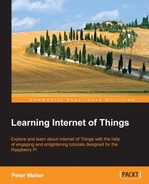In the previous chapters of this book, we studied various communication protocols that are suitable for use in Internet of Things (IoT). So far, all our applications have been self-contained, and we have explicitly developed all the interfaces that are required for the applications to work. In this chapter, we will look at the benefits of using a service platform for IoT when we build services. Not only will it provide us with a suitable architecture and hardware abstraction model suitable for communication over a wide variety of protocols, it will also provide us with tools and interfaces to quickly host, administer, and monitor our services. It will also help us with a wide array of different development tasks making service development for the IoT much quicker and easier by removing or reducing repetitive tasks. By using a service platform, an IoT service developer can focus more of their time and energy on the development of the application logic itself. Thus, they can focus on development that will generate value.
In this chapter, you will learn:
- How to download and install the Clayster IoT service platform
- How to create, run and, debug a Clayster service
- How to use the Clayster Management Tool
- How to use existing XMPP architecture to facilitate development
- How to create 10-foot interface applications that display the state of the controller in real time
Tip
All the source code presented in this book is available for download. Source code for this chapter and the next one can be downloaded from https://github.com/Clayster/Learning-IoT-IoTPlatform.
There are many available platforms that developers can download and use. They vary greatly in functionality and development support. To get an idea of available platforms for IoT and M2M, you can go to http://postscapes.com/internet-of-things-platforms and review the registered platforms. You can then go to their corresponding web pages to learn more about what each platform can do.
Unfortunately, there's neither a way to easily compare platforms nor a comprehensive way to classify their features. In this chapter, we will use the Clayster IoT platform. It will help us with a lot of important tasks, which you will see in this chapter and the next. This will enable you to better assess what IoT platform to use and what to expect when you select one for your IoT projects.
